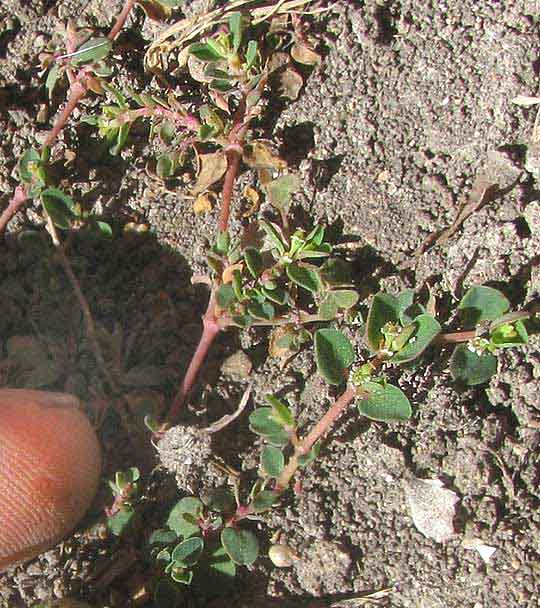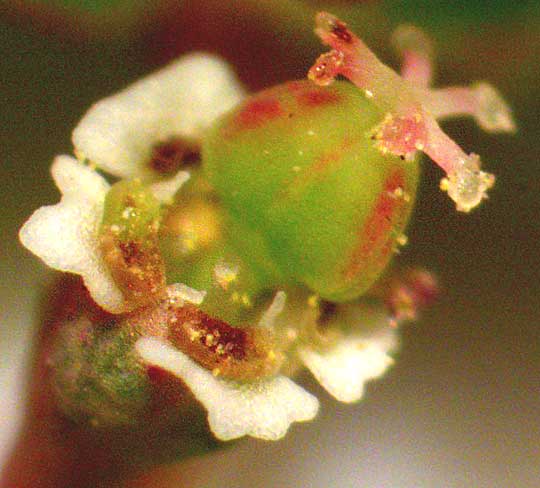Excerpts from Jim Conrad's
Naturalist Newsletter
from the February 3, 2013 Newsletter issued from the valley of the Dry Frio River in northern Uvalde County, southwestern Texas, on the southern border of the Edwards Plateau; elevation ~1750m (~5750 ft); N29.62°, W99.86°; USA
MAT EUPHORBIA
But there was indeed a blossoming wildflower this week, an herbaceous annual so tiny that most folks wouldn't have noticed it, and certainly they wouldn't see the flowers, which are only about 0.5mm across (1/50th inch). Below you can see the mat-forming plant with my finger poking in from the left to show the scale:

In that picture you can barely make out the flowers nestled between opposite leaves on pink stems. A close-up of two blossoms is shown below:

If you know your common wildflowers and weeds already you recognize that this a spurge, a member of the Euphorbia or Poinsettia Family, and more precisely, a member of the huge genus Euphorbia. Euphorbia blossoms are unique among all flowers and in the above picture you can see what's so special about them.
For, the two items in the picture we've been calling flowers are in fact clusters of flowers arising in structures referred to as cyathia (singular cyathium). Notice that from the cyathium on the left a green, oval item bearing five pale, slender things (they're styles, each bearing a deeply lobed stigma) emerges on a stem. The oval item is the ovary, which will mature into a fruit containing seeds. In other words, the female flower is hanging outside the cuplike cyathium. Inside the cyathium reside three to five male flowers, each consisting of no more than a single pollen-producing stamen. A view of a cyathium under a dissecting scope is shown below:

In that picture the five white things we think of as flower petals are "gland appendages"; cyathium flowers bear no corolla or petals. The glands are the sticky-looking, oblong items at the base of each white appendage. Presumably the glands attract pollinators
So, which spurge is this teeny herb with its teeny, flower-like cyathia? Though maybe 2000 species of Euphorbia are recognized worldwide our species was easier than expected to distinguish from all the others because of its small size, lack of hairs, and its mat-forming, herbaceous nature. Among its English names are Mat Euphorbia, Matted Sandmat and Creeping Spurge. It's EUPHORBIA SERPENS, a native of South America, but now established as an invasive nearly worldwide, including most of North America, except for upper Canada, some of the Atlantic states of the US, and the Pacific Northwest. Its habitat is described as stream bottoms, prairies, clay flats and disturbed sites. The cow-frequented dirt below the cabin's south-facing wall qualifies as a disturbed site.
Some authorities place this species in the closely related genus Chamaesyce, so you might find it listed as Chamaesyce serpens.
Of what use is such a modest little plant? Certainly its seeds are eaten by this or that small bird or rodent, plus it tends to form its mats on disturbed soil where other plants aren't growing, so it retards erosion, and replaces naked dirt with oxygen-producing herbage. And when you see the elegance of its tiny flowers you know that its greater value is that it is just itself, being the very best self it can be.